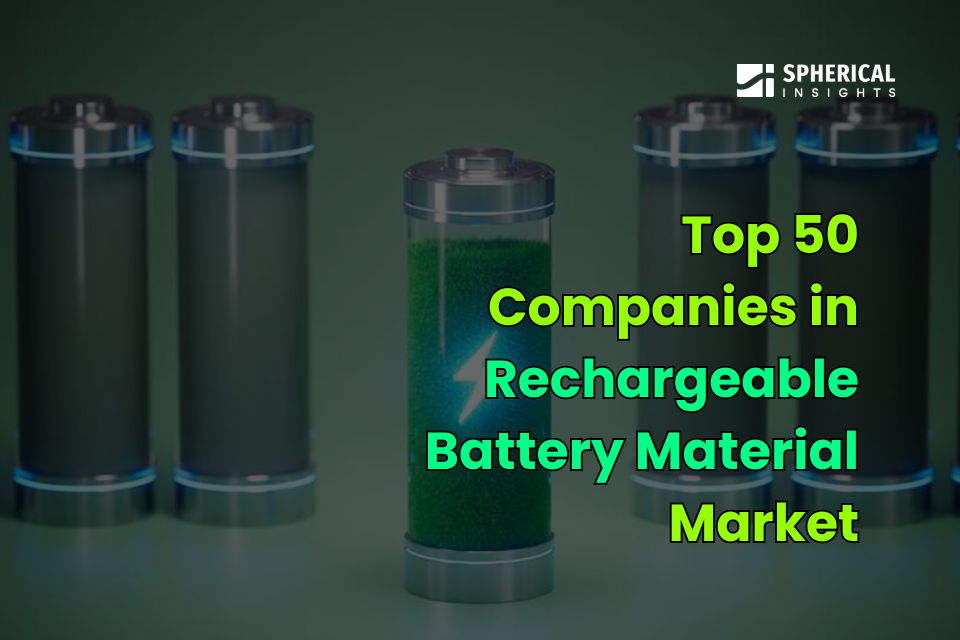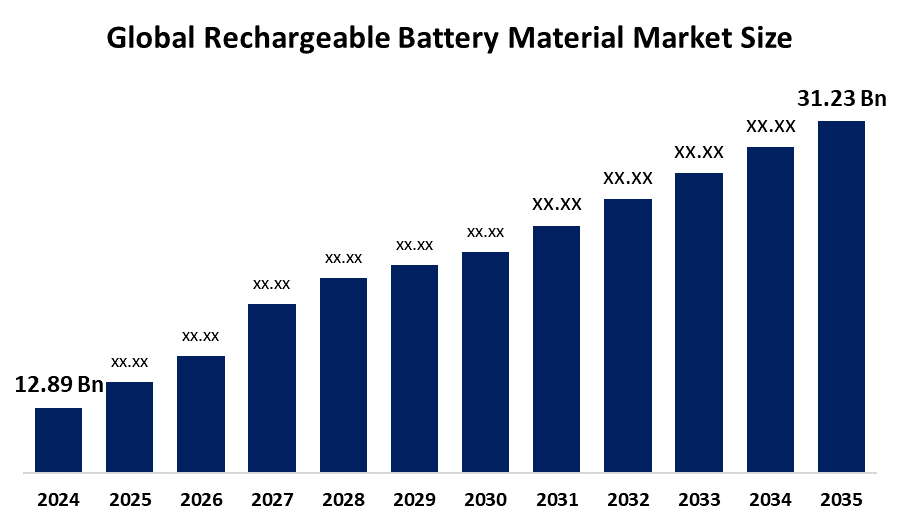
Top 50 Companies in Rechargeable Battery Material Market: Key Insights and Innovations
RELEASE DATE: Sep 2025 Author: Spherical InsightsRequest Free Sample Speak to Analyst
Description
According to a research report published by Spherical Insights & Consulting, The Global Rechargeable Battery Material Market Size is projected to Grow from USD 12.89 Billion in 2024 to USD 31.23 Billion by 2035, at a CAGR 8.38% during the forecast period 2025–2035. The growing demand for electric vehicles (EVs), improvements in battery technology, and the growing demand for energy storage solutions across other industries are all responsible for this remarkable increase. These diverse growth variables are expected to propel the market's strong expansion.
Introduction
The Market Size for Rechargeable Battery Materials is mostly driven by the quick uptake of electric vehicles. Governments all around the world are enforcing strict laws to reduce carbon emissions, which encourages the manufacture and use of EVs. High-performance rechargeable batteries, which depend on cutting-edge components like lithium, nickel, and cobalt, are becoming more and more popular as a result. Additionally, large expenditures on EV infrastructure, like charging stations, are supporting market expansion and generating a positive feedback loop that raises supply and demand for battery components. Another key driver of growth is the development of battery technology. Innovations like solid-state batteries, which provide improved safety and a higher energy density than conventional lithium-ion batteries, are fueling the need for specific materials. Furthermore, research and development initiatives to increase battery efficiency, life, and charge time are creating new opportunities for material producers. High-quality materials that can satisfy these higher criteria are becoming more and more necessary as battery technologies advance, which is driving market expansion.
Navigate Future Markets with Confidence: Insights from Spherical Insights LLP
The insights presented in this blog are derived from comprehensive market research conducted by Spherical Insights LLP, a trusted advisory partner to leading global enterprises. Backed by in-depth data analysis, expert forecasting, and industry-specific intelligence, our reports empower decision-makers to identify strategic growth opportunities in fast-evolving sectors. Clients seeking detailed market segmentation, competitive landscapes, regional outlooks, and future investment trends will find immense value in the full report. By leveraging our research, businesses can make informed decisions, gain a competitive edge, and stay ahead in the transition toward sustainable and profitable solutions.
Unlock exclusive market insights-Download the Brochure now and dive deeper into the future of the Rechargeable Battery Material Market.
Rechargeable Battery Material Market Size & Statistics
- The Market Size for Rechargeable Battery Material Was Estimated to be worth 12.89 Billion in 2024.
- The Market Size is Going to Expand at a CAGR of 8.38% between 2025 and 2035.
- The Global Rechargeable Battery Material Market Size is anticipated to reach USD 31.23 Billion by 2035.
- North America is expected to generate the highest demand during the forecast period in the Rechargeable Battery Material Market.
- Asia-Pacific is expected to grow the fastest during the forecast period in the Rechargeable Battery Material Market.

Regional growth and demand
Asia-Pacific is expected to grow the fastest during the forecast period in the rechargeable battery material market. The region's strong automobile sector, large expenditures in battery manufacturing facilities, and the existence of top battery manufacturers are all responsible for this dominance. Leading nations in battery production and innovation include China, Japan, and South Korea. The demand for rechargeable battery materials is being driven by China's strong push towards electric vehicles and its large investments in battery technology. With a heavy emphasis on battery technology research and development, South Korea and Japan are also important players.
North America is expected to generate the highest demand during the forecast period in the rechargeable battery material market. Energy storage systems and electric vehicles are becoming increasingly popular, especially in the United States. The demand for innovative battery materials is rising as a result of government policies and incentives supporting electric vehicles and renewable energy. Furthermore, North America's concentration of top research institutes and technological businesses is propelling advancements in battery technology.
Top 5 trends in the Rechargeable Battery Material Market
- Rapid growth in electric vehicle (EV) battery demand
- Development of high-energy-density and solid-state materials
- Focus on supply chain security and material sourcing
- Advances in battery recycling and circular economy models
- Rising sustainability and environmental regulations
1. Rapid growth in electric vehicle (EV) battery demand
The surge in EV adoption is driving unprecedented demand for rechargeable battery materials, including lithium, nickel, cobalt, and manganese. This trend is fueling large-scale investments in new material supply chains and production capacity expansions across key global markets, making EVs a primary force shaping the battery materials landscape.
2. Development of high-energy-density and solid-state materials
Innovations in anode and cathode chemistries, such as silicon-boosted anodes and next-generation solid-state electrolytes, are propelling significant advances in safety, energy density, and cycle life. These technological breakthroughs are accelerating industry shift towards batteries that deliver longer range and faster charging, critical for automotive and portable electronics markets.
3. Focus on supply chain security and material sourcing
Increased dependence on scarce battery materials has made supply chain reliability and ethical sourcing a top priority. Governments and companies are seeking geographic diversification, responsible mining, and alternatives to critical minerals to shield operations from geopolitical risks and raw material shortages.
4. Advances in battery recycling and circular economy models
Rising material prices and end-of-life regulations are spurring strong growth in battery recycling technologies, enabling recovery of valuable metals and reducing reliance on virgin resources. Circular economy models are gaining traction as both industry and policymakers push for lower waste, higher reuse, and enhanced sustainability of battery value chains.
5. Rising sustainability and environmental regulations
Stringent emissions and recycling regulations are compelling battery manufacturers to improve the environmental footprint of their materials and production processes. As a result, companies are investing in greener manufacturing, cleaner chemistries, and carbon footprint reduction initiatives to stay compliant and meet customer expectations.
Empower your strategic planning:
Stay informed with the latest industry insights and market trends to identify new opportunities and drive growth in the rechargeable battery material market. To explore more in-depth trends, insights, and forecasts, please refer to our detailed report.
Top 25 Companies Leading the Rechargeable Battery Material Market
- CATL (Contemporary Amperex Technology Co., Limited)
- BYD Company Ltd.
- LG Chem (LG Energy Solution)
- Panasonic Corporation
- Samsung SDI
- Tianqi Lithium
- Albemarle Corporation
- Umicore
- SQM (Sociedad Química y Minera)
- L&F Co. Ltd.
- BASF SE
- POSCO Holdings
- Neo Lithium Corp.
- Livent Corporation
- Mitsubishi Chemical Corporation
- Johnson Matthey
- Sumitomo Metal Mining Co., Ltd.
- Vale S.A.
- Ganfeng Lithium
- Yahua Group
- Shanshan Corporation
- EVE Energy Co., Ltd.
- Hunan Corun New Energy Co., Ltd.
- Great Wall Motor Company
- Panasonic Energy Co.
1. CATL (Contemporary Amperex Technology Co., Limited) - Ningde, Fujian, China:
CATL is the world’s largest manufacturer of lithium-ion rechargeable battery materials, focusing primarily on electric vehicle (EV) battery-grade cathode and anode materials. The company is advancing solid-state battery technology to enhance energy density and safety. CATL’s leadership in lithium-ion battery materials supports its dominant position in global EV supply chains and extensive R&D investments targeting next-generation rechargeable battery innovations.
2. BYD Company Ltd. - Shenzhen, Guangdong, China:
BYD is a prominent player in rechargeable battery materials with a strong vertical integration in lithium-ion battery manufacturing for EVs and energy storage systems. The company develops advanced cathode and anode materials, aiming to improve battery performance and reduce costs. BYD leverages its materials expertise to support its leading position in electric mobility and renewable energy markets worldwide.
3. LG Chem (LG Energy Solution) - Seoul, South Korea:
LG Chem, under LG Energy Solution, manufactures high-quality rechargeable battery materials including nickel-rich cathodes and silicon-enhanced anodes. The company invests heavily in developing sustainable, high-energy-density materials that improve EV battery range and lifecycle. LG Chem’s battery material innovations are integral to its partnerships with global automotive OEMs and energy storage providers.
4. Panasonic Corporation - Osaka, Japan:
Panasonic is a key supplier of rechargeable battery materials, specializing in cathode and anode components critical for lithium-ion battery cells used in EVs and consumer electronics. The company collaborates closely with automotive manufacturers to advance battery chemistry and performance. Panasonic’s material technologies emphasize reliability and scalability to meet growing global battery demand.
5. Samsung SDI - Seoul, South Korea:
Samsung SDI produces a range of rechargeable battery materials, focusing on high-nickel cathodes and innovative anode materials for high-capacity lithium-ion batteries. The company is expanding R&D efforts into solid-state and next-generation battery materials to improve energy density and safety. Samsung SDI supports its global EV and electronics customers through advanced battery material supply and technology development.
Are you ready to discover more about the rechargeable battery material market?
The report provides an in-depth analysis of the leading companies operating in the global rechargeable battery material market. It includes a comparative assessment based on their product portfolios, business overviews, geographical footprint, strategic initiatives, market segment share, and SWOT analysis. Each company is profiled using a standardized format that includes:
Company Profiles
- CATL (Contemporary Amperex Technology Co., Limited)
- Business Overview
- Company Snapshot
- Products Overview
- Company Market Share Analysis
- Company Coverage Portfolio
- Financial Analysis
- Recent Developments
- Merger and Acquisitions
- SWOT Analysis
- BYD Company Ltd.
- LG Chem (LG Energy Solution)
- Panasonic Corporation
- Samsung SDI
- Tianqi Lithium
- Albemarle Corporation
- Umicore
- SQM (Sociedad Química y Minera)
- Others.
Conclusion
The Rechargeable Battery Material Market Size is poised for significant growth driven primarily by the global shift to electric vehicles, consumer electronics, and renewable energy storage. The market is projected to more than double its value by the mid-2030s, supported by ongoing innovations in battery chemistry that enhance energy density, safety, and lifespan. Despite challenges including raw material supply constraints and environmental concerns, the push toward sustainable sourcing and recycling is shaping the market's future.
About the Spherical Insights & Consulting
Spherical Insights & Consulting is a market research and consulting firm which provides actionable market research study, quantitative forecasting and trends analysis provides forward-looking insight especially designed for decision makers and aids ROI.
Which is catering to different industry such as financial sectors, industrial sectors, government organizations, universities, non-profits and corporations. The company's mission is to work with businesses to achieve business objectives and maintain strategic improvements.
CONTACT US:
For More Information on Your Target Market, Please Contact Us Below:
Phone: +1 303 800 4326 (the U.S.)
Phone: +91 90289 24100 (APAC)
Email: inquiry@sphericalinsights.com, sales@sphericalinsights.com
Contact Us: https://www.sphericalinsights.com/contact-us
Need help to buy this report?